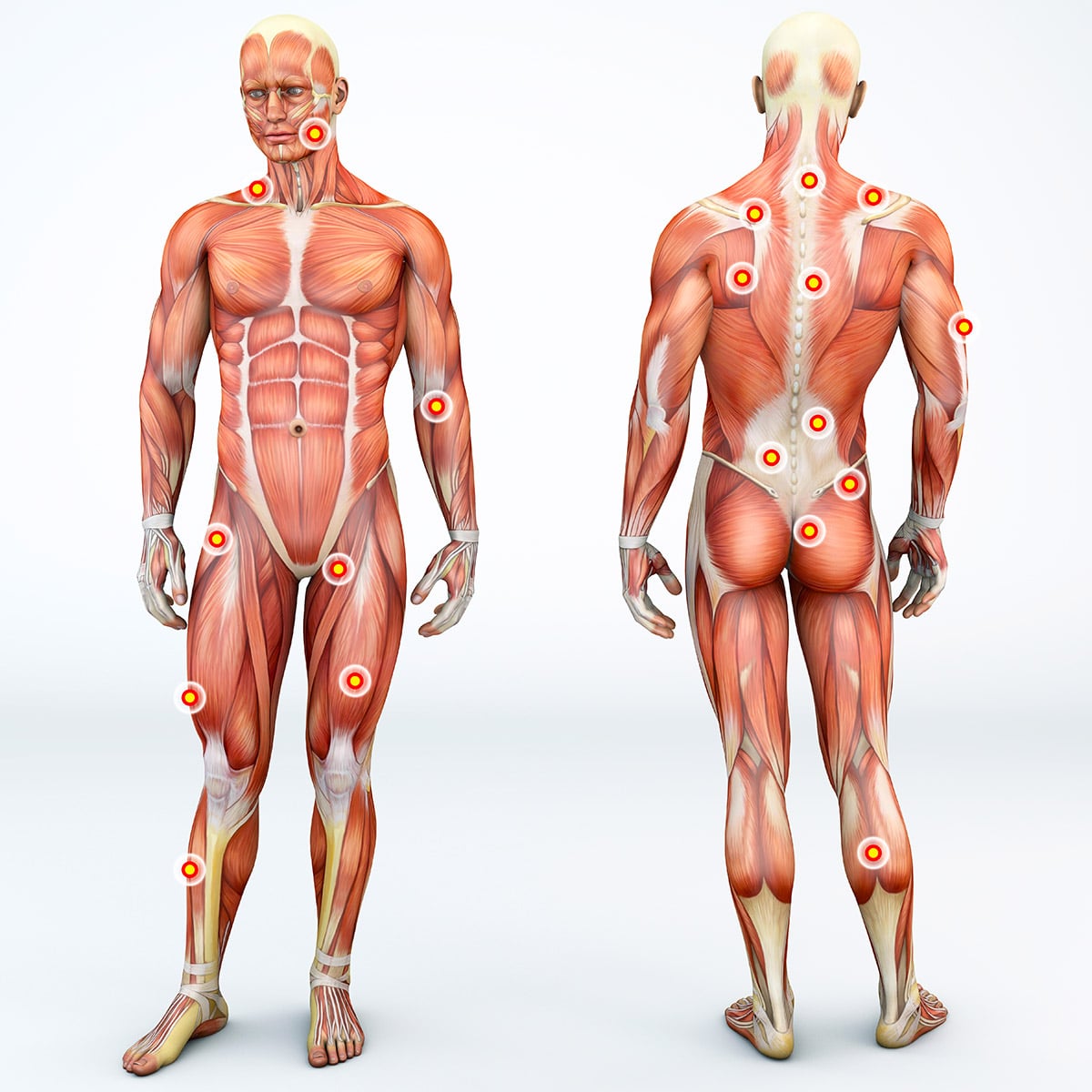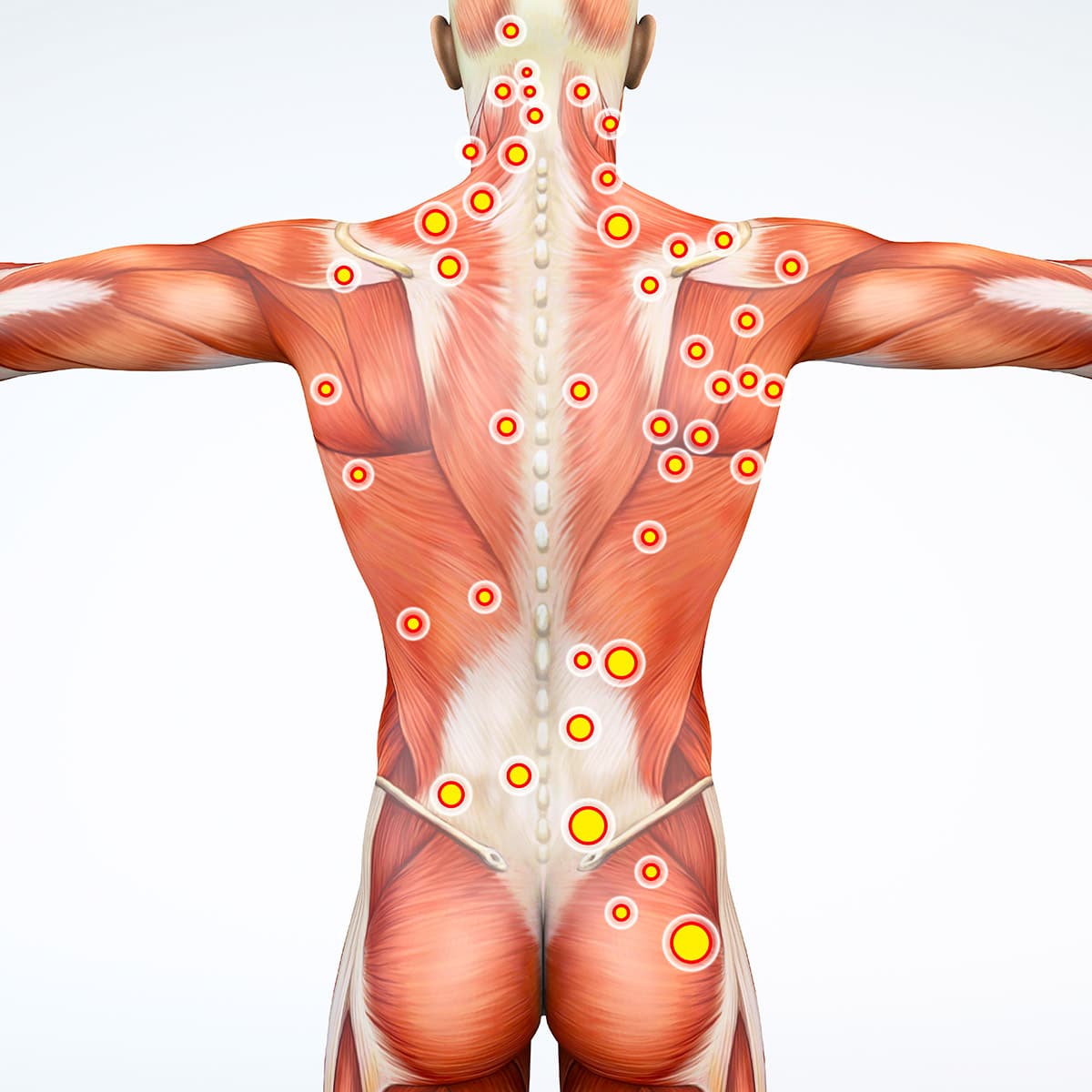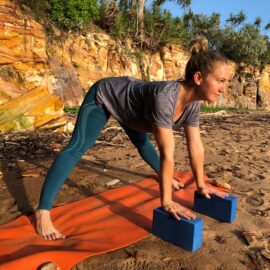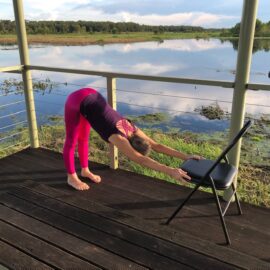How To Break Up Fascia With Yoga
Summary. Why yoga works to help fix your fascia “stiffness”.
How to break up fascia is not a medical term! I simply mean how to keep your fascia in good shape. See how to break up fascia in hips, or break up fascia in the legs, or neck. Learn why yoga does it so well, especially for how to break up muscle fascia. So fascia yoga is a good alternative to chiropractor Darwin NT options. If you want to try fascia massage yoga, then consider Flametree’s fascia and yoga deals at the orange links below, either online or in-studio.
Fascia is a type of stretchy “body-stocking” that covers all your organs, muscles, blood vessels, and nerves. It’s very thick in some places, like on your lower back. Below, the white areas in the pictures show where your fascia is concentrated.
When you are stressed, or not exercising enough, fascia sticks together more, and stops gliding over itself. This means you get stiffer, or experience pain.
You experience pain because fascia is full of nerve endings.
When you have been sedentary, and not exercised enough, your fascia is not working like it should. Accidents, some sports, and work activities, can also misalign your fascia.
For example, swinging a golf club overworks one side of your body. Your body can be like a yacht that does not right itself once the wind subsides.
To keep in good shape, fascia needs to be stretched, and balanced. You also need to de-stress. Yoga is excellent for doing this.
Yoga is a very effective form of fascia massage. It’s also much cheaper than doing one-to-one massage sessions. Try it with yoga options outlined below.
10 HALF price beginner yoga classes, & 2 FREE
Popular yoga passes for all levels. Start fascia massage yoga, & more
Does any one yoga pose work better?
As I’ve said, fascia is a major reason why yoga works so well. But I still often get asked why yoga is so effective for back problems.
I also get asked questions like what is the best yoga pose or poses for back pain, or neck pain, or de-stressing, or other challenges.
The short answer is that there is no one single pose for any of theses issues. But there are many gentle and do-able poses that stretch your fascia.
In turn, stretching your fascia will address many existing issues, or head off others.
The issue is how to break up your fascia ongoingly. It’s also about how to start the process.
Looking after your fascia, and your stress level, will prevent many of the fascia issues I see beginner yoga students struggling with.
An awareness of the importance of fascia also gives you a powerful motivation for doing yoga.
Some understanding of fascia also helps you see why and how yoga works so well, both mentally and physically.
What is fascia?
In short, fascia is a stretchy substance throughout your body.
There are layers of it, and they glide over each other. In turn, it holds you together.
If it is not stretched regularly, it can thicken and stick together. This gives you the ongoing issue of how best to break up your fascia (when its not as flexible as it should be).
Systematically stretching your fascia works well for back issues, as well as many other structural problems or pain that you may have.
It is stretching and re-aligning your fascia that gives the pain reduction, and return to mobility, that students, or potential students, are looking for.
Stress can also cause your fascia to “contort” or get out of alignment.
Again, as you may know, yoga is especially good at de-stressing you. It’s therefore another good reason to understand what’s happening with your fascia.
So this post will explain what fascia is, and why yoga is so good at sorting fascia issues that you may have now, or that could be heading your way.
The white areas on the pictures with this post show where fascia is concentrated on the near the surface of your body. But fascia is also throughout your body.
10 HALF price beginner yoga classes, & 2 FREE
Popular yoga passes for all levels. Start fascia massage yoga, & more

Read on for how to keep your fascia in good shape, including how to break up fascia in hips, or how to break up fascia in the legs,
or how to break up fascia in the neck, or how to break up muscle fascia.
Pain is often to do with how to break up fascia so it works better
Have you ever had lower back pain, or a stiff neck with pain around the shoulder region?
The answer is probably “yes”. That’s because these are the two most common places where we feel pain.
Many of us seek relief with a massage, or an acupuncture treatment.
It’s likely that tightness in your fascia is causing the problem. You can immediately see from the pictures that areas like the lower back have particular concentrations of fascia.
Tightness, or stiffness, may well be just polite way of describing fascia when it is not working as it should.
Modern MRI machines are now showing ugly thickening and tangling of fascia. When in good shape, it is a miraculous “body-stocking” of fascia that is around and within your whole body.
When you are stiff, or in pain, a therapist who knows what they’re doing, they may tell you that you need to stretch more. They may add that you need to find a way to unwind and relax. They’re right!
Fascia, your nervous system, and fascia yoga
Understanding what fascia is, and where it lies in your body, is likely to change the whole way you view pain in your body.
For example, the so-called “Pitta Spot” at the bottom of the right shoulder blade, is a point where there a lot of nerve endings in your fascia.
You can see it in the picture of a back, towards the end of this post.
Ayurveda has known about this Pitta spot for millennia. Modern medical science is still largely unaware of it!
Hence, knowing about fascia, and its concentrations, will also give you a much better sense of why and how to break up your fascia, in the sense of stopping it from thickening up.
As you can see in the picture below, one Flametree Yoga student who has Pitta spot “knot”, spends time each day on our yoga barrel. He’s breaking up his fascia knot. Other students regularly use our barrels when they come to classes in the studio.
Knowing about fascia could also help give you the impetus to make sure you stretch your body every day.

A Flametree student using a barrel, using a form of fascia massage, to break up the fascia around the pitta spot in his back. If you want to try fascia massage yoga, then consider Flametree’s two week free trial, or come along to the Yoga Beginners Introduction, online or in-studio.
More detail about what fascia actually is
Fascia is a thin casting of connective tissue that surrounds every organ, blood vessel and bone in your body.
It provides the internal structure to keep your muscles, nerve fibers, and organs in place. It’s made up of multiple layers, going from superficial to deep.
Fascia is essentially made up of collagen fibers. It’s fibrous, soft connective tissue which is part of a body wide tensional, force transmission system.
It is designed to stretch as you move. In between the layers of connective tissue that make up your fascia, there is also a liquid called hyaluronan.
The fluid helps the many layers of fascia glide over each other as you move.
Although fascia is throughout your body, there’s also some areas, like your lower back, or lower calves of your leg, where it is especially thick.
How to break up fascia has long been ignored
Muscles have long-held centre stage in conventional musculoskeletal anatomy.
Until recently, all anatomy reference books peeled fascia away.
They just showed the human anatomy as comprising just muscles, bones, and ligaments. Such approaches are very incomplete.
The fascia network is over every muscle, every organ, and every bone. It’s throughout the body.
10 HALF price beginner yoga classes, & 2 FREE
Popular yoga passes for all levels. Start fascia massage yoga, & more

It’s another reason why fascia yoga is a good alternative to chiropractor Darwin NT options.
Fascia is the unifying force for our entire body
Fascia provides structure for your body. But it’s more than just wrapping.
Fascia actually has nerves! That makes it almost as sensitive as skin.
Fascia also contains more pain receptors than muscles.
Studies have shown that fascia and the autonomic (or automatic) nervous system are interconnected.
The connective tissue sends messages via the nervous system to the brain.
Fascia responds to stress without your conscious command. It can contract independently of muscles.
When stressed, fascia can thicken and the layers become glued together.
In the process, it can become immobile and inhibit your range of movement. This causes a whole chain of pain reaction throughout your body.
Fascia can tighten, and lead to pain anywhere!
When fascia tightens in one area of the body, it causes pain in not just that area. The ramifications are felt throughout the whole body.
Tightness of the fascia in the outer thigh on one side of the body, for example, will have ramifications for pain felt in other parts of the body.
Tom Myers, the author of “Anatomy Trains”, sees fascia as the missing link in the body movement and stability equation.
Tom Myers has spent the best part of 40 years mapping the whole-body fascia and myofascial linkages. His focus is to understand body movement from a holistic system point of view, rather than the usual “parts” or single muscle point of view.
Tom has mapped fascial ” lines” that run through the body. These provide long tensile straps and slings with the musculature as a whole.
In doing so he has found a way to explain the tensile relationship between muscles and fascia.
Conventional view of muscle
The conventional view is that if you study the insertion and origin of muscles, then you could predict the function of the muscle.
It is now known that many muscles attach to fascia. For example, the majority of gluteus maximus go into the connective tissues surrounding the thigh.
However, just looking at things in terms of muscle, is too simplistic.
Tom Myers maintains that understanding the longitudinal connections between muscles and fascia, and between fascia to fascia linkages, will help us better understand pain. It will also help us consider different strategies to deal with pain.
It is still early in fascia research. However, when you look at an atlas of anatomy, where the fascia has NOT been cut away, it is quite breathtaking.
For example, check out the expansive and dense layers of connective tissue in the sacral to lower back area.
In addition, there is the communicating aspect of the myofasciae. Such communications take place across extended lines and broad plains within the body.
Given that lower back pain is a problem that so many people experience over the course of their lives, it makes sense to look at fascial meridians over the whole body.
This helps understand the how fascia connects the whole body in an endless web.
10 HALF price beginner yoga classes, & 2 FREE
Popular yoga passes for all levels. Start fascia massage yoga, & more
Non beginner deals: from 30 days for $14.95 (AUD), for online, unlimited class

The issue is how to break up fascia in the key area that it can knot up.
For fascia massage yoga, then consider Flametree’s introductory deals in the orange links.
Factors that can cause fascia to tighten
Lack of activity will cause the fascia to thicken, glue together and overtime become immobile, thereby inhibiting your range of movement.
Chronic stress can also cause the fascia to tighten. Other factors that cause issues with your fascia, include:
- Poor posture
- Lack of flexibility or stretching
- Repetitive movements that cause imbalance, such as overdoing on one side of your body, or underdoing on the other side.
You probably already know that over-doing on one side, happens in many sports, such as tennis or golf.
Thickening of fascia can be reversed by stretching
Clearly, yoga is excellent for building flexibility, and it involves a lot of stretching.
The Iyengar style of yoga that Flametree teaches, hold poses, gently, for longer periods. Your fascia is especially nourished by these longer holdings.
Our emphasis on correctly aligning your body in poses, also allows your fascia and energy to flow in natural ways.
So yoga has a huge part to play both in preventing thickening of connective tissue, and resolving thickening once it has happened.
First, a regular yoga practice will stretch fascia over the whole body.
In addition, yoga asanas involve mindful stretching. Iyengar yoga in particular, stretches fascia in a very holistic way.
Alignment of fascia, muscles, and bones is a key part of the Iyengar system.
Attention to stretching back, front and sides of the body evenly, in all postures, ensures that fascia is not pulled unevenly in one direction.
Among other things, all this explains why yoga is especially good at resolving back issues. But that’s just the beginning or how yoga can help via the way it works with your fascia.
When you think about it in this way, you can see that addressing fascia issues is not just about movement.
Yoga that becomes too “aerobic” is likely to not be as helpful as yoga that has more focus on stretching and holding poses. That’s also why restorative yoga is especially useful, as I discuss further below.

Restorative yoga with props, allows longer holding of poses. This works well for fascia yoga. It’s yet another reason why fascia yoga is a good alternative to chiropractor Darwin NT options.
Fascia yoga uses these methods
Some key yogic methods that especially help your fascia include:
- Stretching of all types, including over blocks
- Holding poses such as in Restorative Yoga (as in the picture above)
- Hanging in ropes & swings (to straighten, or compensate for, dysfunctional fascia)
- Rolling on barrels
- Using weights.
The video, at the top of this post, gives you quick demonstrations of such options.
Plus, check out this video of me demonstrating a yoga swing.
Fascia and various yoga poses
Take a key yoga pose like Tadasana (mountain pose). When you practice this pose and stretch the fascia on the bottom of your feet you learn to connect through the fascial system right up to the head.
In Iyengar yoga, props are used like ropes, belts, blocks, and chairs to help a beginner hold the stretch for longer. This will gradually reverse fascia thickening in certain areas.
Where there is thickening of fascia and there is pain in the body, it is necessary to be able to hold a stretch for up to 2-3 minutes. Poses like Uttanasana (standing forward bend), Halasana (upside down forward bend), and Supta Padangusthasana (half angle on your back), can all be held easily for that length of time, when you use props.
You have no doubt also heard of “rolling” as a way of applying external force or weight to an area. It works well to change the architecture under the skin, thereby reducing thickening of fascia layers.
In yoga, we use barrels in the same way, so as to produce the same effect. Rolling over a barrel stretches the whole back body, from the lower back up to the neck.
The friction caused by rolling over the barrel allows the top layer of fascia to start to glide over the deeper layers and reduce fascia thickening.
Rolling across the top of a barrel is also another way to use weight and pressure. See more on using weights below.
Yoga teaches you how to relax within the stretch
Yoga asanas teach you how to use your body to watch your mind.
In the process, it’s especially good for stretching. In turn, that’s a key part of having your fascia in top condition.
Yoga teaches one how to watch the breath, and relax while holding the stretch. It teaches how to breath into the stretch, even though the stretch can be very intense.
Yoga also teaches how to bring the mind into a more contemplative state. Eventually, with practice, you reach a place of meditation within the action.
Many yoga poses specifically “turn” on the rest and relax part of the autonomic nervous system. Poses can also turn off the “fight or flight” part of the autonomic nervous system.
The shoulderstand sequence, forward bends, and supported supine (lying) poses, all work in this way.
Essentially, the mental and mindful approach of yoga, is helping you hold physical stretches. In turn, the holding of the pose is a keep part of why yoga is good for your fascia.
How to break up fascia with restorative yoga
Restorative yoga teaches you how to relax and unwind. This again helps your fascia, and in turn, how you feel.
Learning how to relax is an art that has to be learnt.
In restorative yoga, poses are held for 5 to 10 minutes.
In the process, your whole fascia network gets a chance to spread, and pockets of thickening can be reduced.
The point is that its the process of holding a pose, which is done a lot in restorative yoga, that works especially well for how to break up fascia.
Weights: another way to break up fascia, or do fascia massage
The use of weights in yoga is another area that is best understood in terms of fascia.
Weights are placed on various areas of the body by an experienced teacher. They are left there for 5 minutes or more.
They help reduce fascial thickening in specific areas of the body, and shift energy to realign the body-wide tensional force system.
Many who have had weights used on them are amazed at how the work. It seems miraculous. But fascia is what underlies the approach.
Mr BKS Iyengar made the use a weight a key part of yoga therapy. In doing so, he was working with fascia, and fascia massage.
Regular students will know that even in normal classes, weights as simple a bolster, are sometimes used. It feels good, and works, at least partly because of how it’s working via your fascia.
Conclusion. How to break up fascia ongoingly.
Fascia is key part of your body that is often forgotten.
You’ll find fascia between some muscles, and conglomerations of it in particular parts of your body. It’s not just all over your frame, but also deep within your body.
Books that show your muscles, but not your fascia, are only telling a part of the story.
Thickening and misalignment of fascia can also be a major source of pain, especially back pain. That’s partly because fascia is full of pain “receptors”.
Yoga, with its focus on stretching, is especially good at keeping your fascia in top shape.
Iyengar yoga, with its particular focus on alignment, and getting into poses fully and correctly, is especially good at sorting out issues with your fascia.
In the process, it heads off, or fixes, many of the problems you may have already run into.
As you learn to use yoga to relax, you are impacting the fascia throughout your body. This can even address potential heart issues.
Meditation, including breath meditation, are even more important than you may have thought, because they are a key way to relax. In the process, it is another part of relaxing and fixing issues in your fascia, like thickening.

Excellent fascia yoga stretches happen in most yoga poses. Try it before you invest in chiropractor Darwin NT options.
Overview of some good classes for fascia massage & untangling
Particular types of yoga, like Gentle Yoga, or Back, Neck & Shoulder Yoga, or Easy Restorative Yoga, are especially good for both de-stressing and stretching.
These are especially good classes when you have not been exercising for a long time, or are stiff. As well as improving flexibility, these classes reduce stress, and fix imbalances.
Back, Neck & Shoulder Yoga has a particular focus on stiffness, pain and other issues in various parts of your back, and elsewhere.
A key reason that Backcare Yoga works, as well as any other yoga, is that it is getting your fascia “untangled”, and lubricated.
For this reason, some Flametree students have found that Back, Neck & Shoulder Yoga works, when nothing else has.
Anyone who has issues with stiffness, stress, or repetitive use injuries, will get a lot of value from yoga
Flametree Yoga students also know that I (Chris Lalor) mention fascia a lot.
The Iyengar style of yoga we teach is especially effective for fascia issues. It’s because we sometimes gently hold poses for longer timings.
How to break up fascia. Do fascia yoga.
As we said at the start, how to break up fascia is not a medical term. We simply mean how to keep your fascia in good shape, including how to break up fascia in hips, or break up fascia in the legs, or how to break up fascia in the neck, or how to break up muscle fascia.
If you now have a better sense of the importance of breaking up fascia, and especially if you want to use fascia massage yoga, then consider Flametree’s two week free trial.
All Flametree classes are both online and in-the-studio, including private classes. There is also a large library of yoga videos.






It is amazingly informative.
Hi Shweta. Sorry for delay getting back to you, but thanks for your positive feedback. We love fascia massage yoga, and its key part of our approach to yoga.